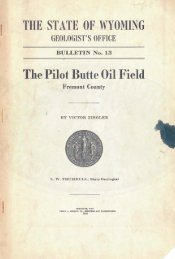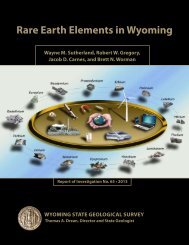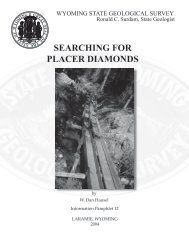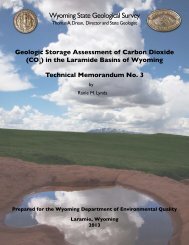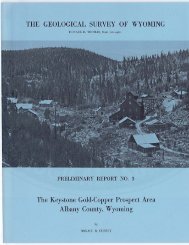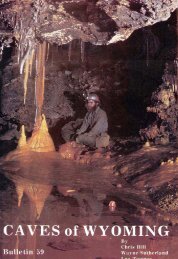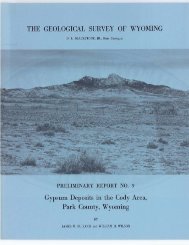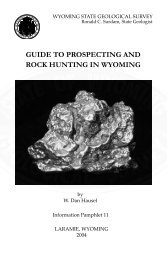The Dinosaurs of Wyoming - Wyoming State Geological Survey ...
The Dinosaurs of Wyoming - Wyoming State Geological Survey ...
The Dinosaurs of Wyoming - Wyoming State Geological Survey ...
You also want an ePaper? Increase the reach of your titles
YUMPU automatically turns print PDFs into web optimized ePapers that Google loves.
CHAPTER XII<br />
<strong>The</strong> "Sacral Brain" <strong>of</strong> <strong>Dinosaurs</strong><br />
<strong>The</strong> unusual enlargement <strong>of</strong> the spinal canal in the dinosaurs<br />
has long been known and commented upon by various<br />
authors, and many attempts have been made to explain the<br />
presence, in the sacral region, <strong>of</strong> a mass <strong>of</strong> nerve material<br />
<strong>of</strong>ten many times larger than the brain. It must be remembered,<br />
however, that there was a large space around this<br />
"sacral brain" and a cast <strong>of</strong> the cavity in the sacrum is probably<br />
twice the size <strong>of</strong> the actual enlargement in the spinal<br />
corel.<br />
<strong>The</strong> best discussion <strong>of</strong> this "sacral brain" is that given by<br />
Pr<strong>of</strong>essor R. S. Lull, Pr<strong>of</strong>essor <strong>of</strong> Vertebrate Paleontology at<br />
Yale University, and I am quoting extensively from his article,<br />
"On the Functions <strong>of</strong> the 'Sacral Brain' in <strong>Dinosaurs</strong>."<br />
<strong>The</strong> complete reference will be found in the bibliography.<br />
"Branca, in a discussion <strong>of</strong> the fauna <strong>of</strong> 1'endaguru, East<br />
Africa, makes a number <strong>of</strong> thought-inspiring comments upon<br />
the huge sauropod dinosaurs which the formation contains.<br />
Among other points he is striving to account for the maintenance<br />
<strong>of</strong> their immense bulk upon a possibly meagre diet by assuming<br />
digestive powers <strong>of</strong> extraordinary efficiency. For this<br />
he <strong>of</strong>fers the following explanation:<br />
"One may be inclined to look for the ability to take care <strong>of</strong><br />
food solely in the stomach, intestines, or liver. However, in the<br />
dinosaurs we may take into consideration something else, i. e.,<br />
the 'sacral brain,' if we look upon the swelling <strong>of</strong> the spinal<br />
column in the sacrum as a 'brain.' According to W.aldeyer, it is<br />
indeed thinkable that the sacral brain in dinosaurs had a certain<br />
independence, and cared for the functions <strong>of</strong> nourishment,<br />
digestion, and procreation [bold type mine], also that through a<br />
particularly strong innervation it had become especially powerful,<br />
more powerful than the strongest digestive organs could be<br />
without such a sacral brain. In man there appear still to be<br />
traces <strong>of</strong> this, but here the sacral section <strong>of</strong> the spinal column<br />
is completely surpassed by the braili.<br />
Dinosaurian Feeding Habits<br />
"Our assumption <strong>of</strong> feeding habits based upon the character<br />
<strong>of</strong> dinosaurian dentition justifies the following conclusions:<br />
"<strong>The</strong>ropoda-<strong>The</strong>se are the carnivorous dinosaurs in a<br />
strict sense, with teeth which were in the main prehensile and<br />
as such confined to the forward portion <strong>of</strong> the jaws. <strong>The</strong>y<br />
must have been used for rending the prey, for in many instances<br />
they are sharp-pointed and compressed, with finely serrated<br />
59




